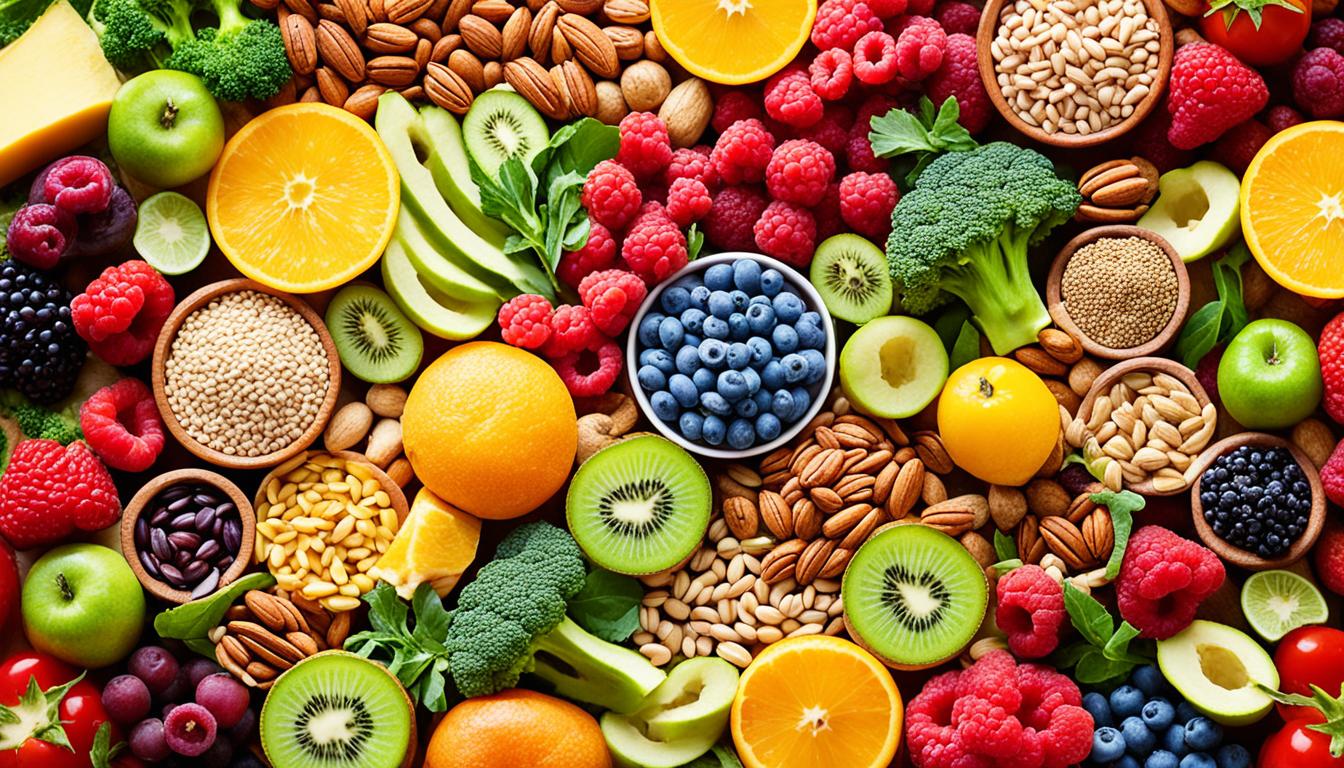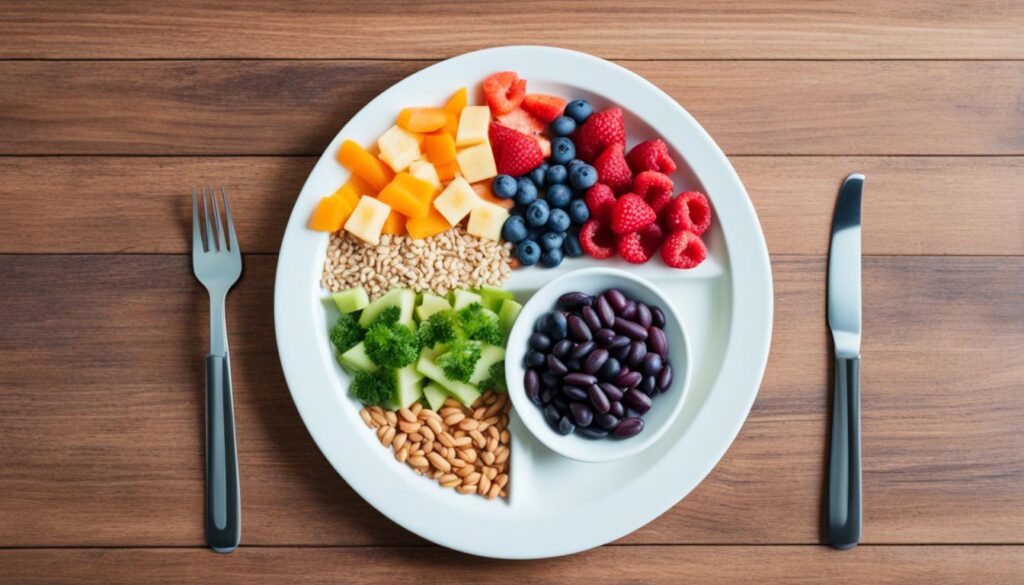Physical Address
304 North Cardinal St.
Dorchester Center, MA 02124
Physical Address
304 North Cardinal St.
Dorchester Center, MA 02124

Discover the remarkable benefits of fiber for your overall health - regulate digestion, aid weight management, and reduce disease risk with a fiber-rich diet.
Fiber is key for a healthy diet and helps your health in many ways. You mainly find it in fruits, vegetables, whole grains, and legumes. There are two types: soluble, which mixes with water, and insoluble, which doesn’t. Soluble fiber can work to lower bad cholesterol and sugar levels. Meanwhile, insoluble fiber helps keep things moving in your gut and makes stools bigger. Eating lots of fiber can make your trips to the bathroom regular, keep your bowels healthy, lower cholesterol and sugar levels, help with weight control, and cut the chances of getting sick from chronic diseases.
For men under 50, the goal is 38 grams of fiber a day. Men over 51 aim for 30 grams. Women under 50 should get 25 grams, and those 51 and older need 21 grams. The best way to get your fiber is from whole foods like fruits, veggies, whole grains, beans, nuts, and seeds. If you feel like you’re not getting enough, you might consider fiber supplements. But be careful not to overdo it ’cause too much fiber could cause tummy troubles.
Dietary fiber is in plant foods but our bodies can’t break it down. It travels through the body without becoming a part of it. This happens in the stomach, small intestine, and colon.
There are two types of fiber: soluble and insoluble. Soluble fiber dissolves in water and helps lower bad cholesterol and sugar levels. Insoluble fiber doesn’t dissolve and keeps our digestive system moving smoothly.
You can find dietary fiber in many plant foods. Good sources are whole grains, fruits, vegetables, beans, peas, nuts, and seeds. Eating these natural foods is the best way to get more fiber in your diet.
A high-fiber diet boosts your health in many ways. It helps keep bowel movements regular and supports digestive health. Plus, it guards against constipation and diarrhea. Fiber’s filling nature can also aid weight management by preventing overeating.
Fiber comes in two forms: soluble and insoluble. Both are key for a healthy gut. Soluble fiber lowers cholesterol by trapping it in the gut. Insoluble fiber, on the other hand, keeps things moving and bulks up your stool.
High-fiber diets make you feel full longer, cutting down on snacking. They also slow down sugar absorption, helping to control blood sugar. This reduces the risk of overeating and thus, helps keep a healthy weight.
Fiber and cholesterol are closely related. Soluble fiber cuts down on LDL (bad) cholesterol by pulling it out of your system. This can help keep your cholesterol levels in check and lessen your heart disease risk.
Fiber and blood sugar have a crucial link. Fiber slows down sugar absorption, preventing blood sugar spikes. It’s especially helpful for people with or at risk of type 2 diabetes.
Research indicates that more fiber, especially from cereals, leads to a lower risk of heart disease and cancer. Lowering these risks is key to a long and healthy life.

The Institute of Medicine suggests how much fiber adults should aim for each day:
But, most adults in the U.S. miss this goal. Only 5% of men and 9% of women get enough fiber daily.
| Age and Gender | Recommended Daily Fiber Intake |
|---|---|
| Men 50 or younger | 38 grams |
| Men 51 or older | 30 grams |
| Women 50 or younger | 25 grams |
| Women 51 or older | 21 grams |
Many Americans fall short of the fiber guidelines. This shows we need to know more and eat more high-fiber foods.
The best way to eat more fiber is by adding whole, plant-based foods to your meals. These foods, like fruits, vegetables, and nuts, are full of fiber and good for your health.
Brown rice, whole wheat, and oats are great choices for fiber. They keep their natural layers, which are full of fiber. Make your diet healthier by choosing whole grains instead of refined ones.
Fruits and vegetables with skins or peels are rich in fiber. Adding foods like raspberries, apples, and green peas to your meals is an easy way to increase your fiber intake.
Legumes, such as beans, and nuts, like almonds, are good sources of fiber too. For example, split peas have a lot of fiber. By adding these foods to your meals, you get the fiber you need.
On the other hand, processed foods have less fiber. That’s because the fiber parts of grains are often taken out when they are made. It’s better for your health to choose foods that are less processed.
Fiber is key to staying healthy and avoiding serious health issues. It helps the gut work well, keeps blood sugar stable, and lowers bad cholesterol. These actions lower the chance of heart disease, type 2 diabetes, and some cancers. Besides, fiber feeds good gut bacteria, which is crucial for fighting off sickness and getting all the nutrients you need.
Adding more fiber-rich foods to what you eat is really important for a healthy life.
Eating more dietary fiber, especially from cereals, cuts the risk of dying from heart disease and cancer. Foods rich in soluble fiber, like beans and oats, can reduce bad cholesterol. This keeps your heart healthier and your blood pressure lower. Plus, these foods make you feel full quickly and stay full longer, which helps control blood sugar and weight. For diabetics, this is especially important.
A diet high in fiber also helps prevent issues like hemorrhoids, diverticular disease, and certain cancers. It does this by making going to the bathroom easier, which reduces the risk of constipation. Some types of fiber go through a process in the colon that is linked to lower colon disease risks.

Are you looking to get more fiber in your diet? There are easy ways to do this. By adding high-fiber foods to what you eat every day, you can reach the recommended amount of fiber. Plus, you’ll enjoy the many benefits of fiber.
Choosing a high-fiber breakfast is a great first step. Options like fiber-rich cereals, oatmeal, or chia pudding can jump start your fiber intake. These choices give you a good amount of your daily fiber right in the morning.
Swap out refined grains for whole-grain alternatives like brown rice, whole wheat bread, and quinoa. These choices keep the outer layers that are full of fiber. They’re a better source of this important nutrient.
Choose fiber-dense snacks such as fruits, veggies, nuts, and seeds. These fiber-rich options for snacking can help you reach your daily fiber goal. They also add a nice crunch and different flavors to your day.
Increasing fiber slowly, along with drinking enough water, helps avoid tummy troubles. With some planning and creativity, you can add more high-fiber diet options to your meals easily.
Eating whole foods rich in fiber is best. But Fiber Supplements and Fiber-Fortified Foods help too, especially for some people. For example, those with certain health problems find it hard to get enough fiber from food. Cereals, bread, and yogurt are some processed foods with extra fiber. Still, eating too much fiber from these added sources can cause stomach problems like bloating or constipation.
Some people can’t eat enough fiber through regular food. In these cases, Fiber Supplements can be very helpful. They make sure you get the right amount of fiber, which is important for your health. Fiber keeps your stomach and digestion working well, helps control sugar and cholesterol, and lowers disease risks.
But, talking to a doctor before starting fiber supplements is a must. This is because they might not be good for you if you’re taking certain medicines or have other health issues.

When upping your fiber intake, do it slowly. Your body needs time to adjust. If you add too much fiber too quickly, you might get bloated, gassy, or backed up. To avoid this, drink more water as you boost your fiber intake.
Staying hydrated is key for fiber to move smoothly in your system. By increasing fiber slowly and drinking enough, you can avoid tummy troubles. This approach helps your body get used to more fiber without the icky side effects.

Dietary fiber is super important for staying healthy. It’s found in foods like whole grains, fruits, veggies, legumes, and nuts. These foods help your digestion, keep your weight in check, and balance your blood sugar and cholesterol.
It’s best to get your fiber from these natural foods. This way, you can avoid chronic diseases. But, sometimes supplements and fortified foods can also be helpful.
Increasing your fiber intake takes time and effort. But it’s worth it for your health. Fiber helps fight off heart disease, diabetes, and some cancers.
So, focus on eating foods high in fiber every day. Doing this will keep you healthy and feeling good for years to come.
In the end, fiber is key for good health. It boosts your body and mind, starting you on a path to a long, healthy life.